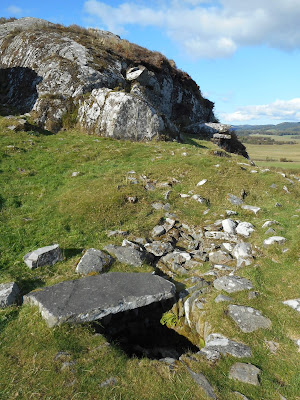The short answer is that from the moment of the previous holder's death until the moment when the apparent heir's identity is formally recognised by his or her superior, the ownership of the land went into a legal limbo, known in Latin as in hereditas jacens. The apparent heir had a year and a day to decide first of all whether he or she wished to inherit the property - after all, if it was saddled with debts, what would be the point?! This period of time was known as the tempus deliberandi or annus deliberandi - the time or year of decision.
If the apparent heir now wished to proceed, there were a couple of options available. The first was to just push on quickly and complete the inheritance process, by going through the Services of Heirs procedure (if the land was held of the Crown), or obtaining the precept of clare constat (if held of a subject superior, or middle man on the feudal chain).
However, an alternative was to take up partial possession of it with some protection against creditors, before the inheritance process was even commenced or completed. To do so, the apparent heir could take up what was known as entry cum beneficio inventarii - entry with the benefit of an inventory.
Within the first year after the predecessor’s death an inventory of the estate’s value could be drawn up and recorded by the local sheriff-clerk within the sheriff court books, which allowed the apparent heir to restrict the value of any debts owed by the estate to that stated in the inventory. After the annus deliberandi expired, the inventory could also be subsequently recorded in the Books of Council and Session (the Register of Deeds) within the next forty days.
Having taken up informal possession, the apparent heir was still an apparent heir, as the title had yet to be completed. As such, he or she could not sell off parts of the land or property, and only had limited rights to its assets. Nevertheless, for some, that was enough, and it would only be many years later when they did decide that they wanted to carve off parts of their estate that they perhaps decided then to complete the inheritance process.
 So what's the bottom line? In some cases, this means that you may find that an heir is not recorded in the Services of Heirs indexes, or indeed in the sasines registers, until many, many years later after first gaining entry - and in some cases, not at all, if they left it too late and went off to meet their maker before their time was supposed to be up.
So what's the bottom line? In some cases, this means that you may find that an heir is not recorded in the Services of Heirs indexes, or indeed in the sasines registers, until many, many years later after first gaining entry - and in some cases, not at all, if they left it too late and went off to meet their maker before their time was supposed to be up.For more on the various methods of land holding, inheritance and other related topics, don't forget my book Discover Scottish Land Records (2nd edition), which might help. Details on how to buy the book from various worldwide outlets is available at http://britishgenes.blogspot.co.uk/p/my-books.html.
I hope it helps!
Chris





















